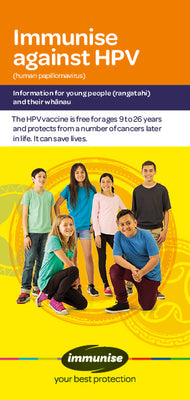Immunise against HPV (human papillomavirus) – English version – HE2012

Pamphlet in English explaining vaccination against human papillomavirus (HPV).
The full resource:
Information for young people (rangatahi) and their whānau
The HPV vaccine is free for ages 9 to 26 years and protects from a number of cancers later in life. It can save lives.
What is HPV?
HPV is a group of very common viruses that infect about 80% of people in their teenage years. HPV spreads through intimate skin-on-skin contact.
Most HPV infections get better on their own and don’t cause any obvious problems. However, they can cause several cancers (such as cervical and throat cancer) later in life for all genders.
Getting the free HPV vaccine
The HPV vaccine is called Gardasil® 9. It is very effective at preventing nine types of HPV.
School vaccinations
Most rangatahi are offered the vaccine at school, usually in Year 7 or 8. This is the best time to immunise them, as a pre-teen's immune system is really effective at making antibodies in response to the vaccine and protection is long lasting.
Rangatahi aged 9 to 14 years need two doses.
Immunisations outside of school
If your school is not offering HPV immunisation, or your child has missed out for any other reason, they can easily catch up with a visit to your medical centre or practice nurse. This is also an option if you would like to be with your child when they get their vaccination.
Immunisation for ages 15 to 26
The HPV vaccine is free and available for ages 9 to 26 years.
If the first dose of the HPV vaccine is given after age 15, then three doses are needed.
Side effects
The HPV vaccine has an excellent safety record but, like all medicines, it may cause
side effects.
The most common side effect is a sore arm from the injection - you can put a cold cloth
or ice pack on it to feel better.
Other common side effects include:
- a headache
- feeling tired, dizzy, or sick
- feeling feverish or sweaty.
Very rarely, a severe allergic reaction (anaphylaxis) can happen after a vaccination. Those being vaccinated will be observed for 20 minutes after the immunisation so that any reaction can be treated. Vaccinating teams are trained to manage anaphylaxis and have the equipment for this.
Those recovering from illnesses such as a cold, flu, or COVID-19 (after isolation) can
still be immunised as long as they do not have a fever.
Anyone who has had a severe allergic reaction to a vaccine in the past should discuss immunisation with their usual doctor or medical centre.
Tips for preparing for immunisation
Some food before or after can help prevent feeling faint or dizzy.
Wearing a loose shirt with short sleeves will make things easier because the vaccinations are given in the upper arm.
If the arm is sore, take things easy after the vaccination.
More information
For more information, talk to your doctor, practice nurse, vaccinator, or medical centre. You can also visit HPV (human papillomavirus) vaccine | Immunise | Te Whatu Ora or phone Healthline: 0800 611 116.
Information about the National Cervical Screening Programme can be found at www.timetoscreen.nz/cervical-screening
Code: HE2012.
